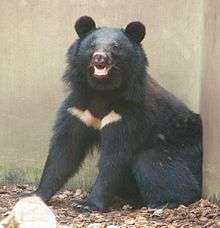Japanese black bear
| Japanese black bear | |
|---|---|
 | |
| Scientific classification | |
| Kingdom: | Animalia |
| Phylum: | Chordata |
| Class: | Mammalia |
| Order: | Carnivora |
| Family: | Ursidae |
| Genus: | Ursus |
| Species: | U. thibetanus |
| Subspecies: | U. t. japonicus |
| Trinomial name | |
| Urus thibetanus japonicus Schlegel, 1857 | |
| Synonyms | |
|
Selenarctos thibetanus japonicus | |
The Japanese black bear (Urus thibetanus japonicus) is a subspecies of the Asian black bear that lives on three main islands of Japan: Honshu, Shikoku and Kyushu. There are said to be 10,000 black bears on Japan. The population of black bears on Shikoku and Kyushu may be endangered or extinct. there is a high price on bear parts in the black market, which threatens all bear populations in Japan. This particular species of bear are typically smaller with males only reaching 60-120 Kg and females only weighing about 40-100 Kg. Their body length is about 120-140 cm long. They feed by climbing trees and eating their berries and nuts.
Diet
These Bears usually are typically herbivorous eating mainly grasses and herbs during the spring. During the summer, they switch to berries and nuts to feed themselves for their hibernation. The bear is able to get the berries and nuts by climbing the tree and using their claws to grab the food. These bears can also be omnivorous and eat other wild animals and livestock when they need to. There is cannibalism in these bears, proven by bone parts and claws of a cub inside the stomach of a male black bear.
Habitat
These bears live on three Japanese islands, Honshu, Shikoku, and Kyushu. These bears can be found in the northeastern high snow region and the southwestern low snow region. They have been spotted as high as the alpine region more than 3,000 meters high. They live in areas where there is an abundance of grasses and trees with berries to support their diet.
Conservation of black bears
There has been a huge impact on these bears populations due to human interference. Habitat destruction is a huge problem for these bears as peoples' villages begin to grow. Over-Hunting and poaching is also a huge problem. Bears parts can be sold in the black-market for top dollar, which makes them very desirable. People kill a lot of these bears reducing there number drastically. Because of this and the carrying capacity reduction due to habitat destruction has made the black bear to be labeled as having a high risk of extinction. The species will likely be gone within the next 100 years at the rate they are declining currently.
References
- Horino, S.; Miura, S. (2000). "Population viability analysis of a Japanese black bear population". Population Ecology. 42 (1): 37–44. doi:10.1007/s101440050007.
- Hazumi, Toshihiro (1994). "Status of Japanese black bear". Bears: Their Biology and Management. pp. 145–148. doi:10.2307/3872694. JSTOR 3872694.